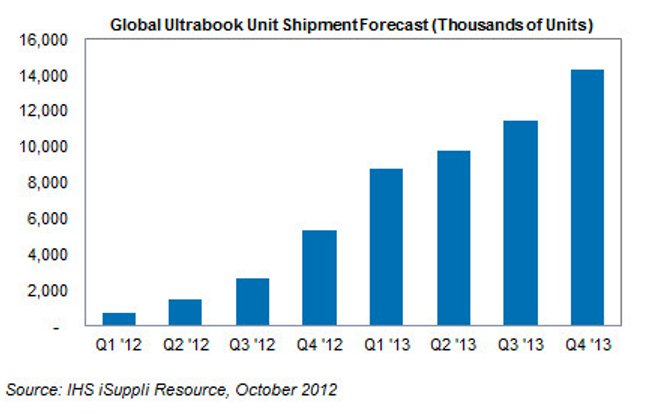Expensive products and rubbish marketing strategies are to blame for ultrabooks sales forecasts being slashed 50pc, IHS iSuppli says. Some 10.3m ultrabooks will ship in 2012, down from the 22m forecast earlier this year.
Poor marketing that failed to draw consumers’ attention from other hot-selling products was a key factor but perhaps the most dominant factor is the price of the devices.
It is a worthy lesson for Windows-based manufacturers ahead of the launch of Microsoft’s Windows 8 operating system and tablet/PC combos based on the new Surface form factor.
Along with the revised figures for 2012, shipments have also been modified for the next year, projected to rise to 44m in 2013, down from the older outlook of 61m.

Dude, you’re not getting a Dell
“There once was a time when everyone knew the ‘Dude you’re getting a Dell’ slogan. Nowadays no one can remember a tag line for a new PC product, including for any single ultrabook,” said Craig Stice, senior principal analyst for compute platforms at IHS.
“So far, the PC industry has failed to create the kind of buzz and excitement among consumers that is required to propel ultrabooks into the mainstream. This is especially a problem amid all the hype surrounding media tablets and smartphones. When combined with other factors, including prohibitively high pricing, this means that ultrabook sales will not meet expectations in 2012.”
Even so, challenges stemming from the nebulous marketing and unappealing price surrounding the ultrabook can be overcome, IHS predicts, paving the way for shipments to rise by more than 300pc in 2013. Growth is also expected to continue for the foreseeable future, with shipments expanding to 95m units by 2016. This will drive long-term growth for devices used in ultrabooks, including motion sensors.
Ultra-priced ultrabooks?
Beyond the marketing shortcomings, ultrabooks need to get more systems down to the US$600 price range in order to hit the volume level needed to enter the mainstream, down from prices at the US$1,000 level now.
If ultrabooks using the new Windows 8 operating system come close to the US$600-US$700 range next year, while adding in an attractive new consumer feature such as touchscreen, a good chance exists for strong sales in 2013.
If not, and ultrabooks stay at the US$1,000 level, their sales will continue to struggle in 2013 as they must compete against lower-priced options, such as tablets and smartphones.
“With the economy languishing, ultrabook sellers may have trouble finding buyers at the current pricing, especially with fierce competition from new mobile computing gadgets, such as the iPhone 5, Kindle Fire HD and forthcoming Microsoft Surface,” Stice said.
Another factor causing IHS to reduce the forecast is Intel’s increasingly stringent set of definitions for ultrabooks. Based on these designations, many notebooks once called ultrabooks now are being classified as “ultrathins.”
Everything will come together next year
While Intel Corp hasn’t given up on ultrabooks in 2012, the microprocessor giant at its Intel Developer Forum (IDF) this month turned its attention to next year, when it believes that everything will come together with the mid-2013 introduction of the company’s new microprocessor – dubbed Haswell. Intel described 2013 as a once-in-a-decade opportunity for companies to reinvent the PC, with its new Haswell microprocessor catalysing the ultrabook revolution.
Haswell, Intel’s fourth-generation core microprocessor family, will offer better performance with lower power consumption. Because of these attributes, Haswell will serve as the main core microprocessor for ultrabooks. The microprocessor will provide Intel Identity Protection Technology to improve security, and will also support multiple displays and high-definition 4K monitors with DisplayPort 1.2.
Future form factors
Beyond the ultrathin and ultralight form factor, Intel at IDF focused on new consumer-friendly features to enhance the attraction of ultrabooks.
The focus at several briefings centred on touchscreen technology in ultrabooks, in conjunction with the Windows 8 launch in October. Intel at IDF claimed there are 40 ultrabook designs in progress with touchscreens.
The company also provided a survey showing that when consumers are given a choice, touch was chosen as a desired feature 80pc of the time.
Intel highlighted convertible form factors for ultrabooks, calling them the “best of both worlds.” These notebooks with detachable screens work as a traditional clamshell mobile PCs, but they can also be converted into tablets by pulling the screen off the keyboard.
Other prominent new features being incorporated into the next-generation ultrabooks are voice recognition; security features; multiple sensors including GPS, accelerometers and gyroscopes; and hand-gesture recognition, an attractive option for the gaming market.